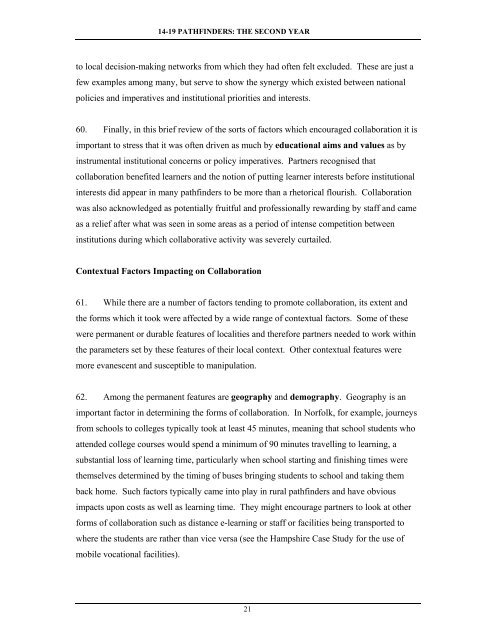Collaborative Approaches to 14-19 Provision - Communities and ...
Collaborative Approaches to 14-19 Provision - Communities and ...
Collaborative Approaches to 14-19 Provision - Communities and ...
- No tags were found...
Create successful ePaper yourself
Turn your PDF publications into a flip-book with our unique Google optimized e-Paper software.
<strong>14</strong>-<strong>19</strong> PATHFINDERS: THE SECOND YEAR<strong>to</strong> local decision-making networks from which they had often felt excluded. These are just afew examples among many, but serve <strong>to</strong> show the synergy which existed between nationalpolicies <strong>and</strong> imperatives <strong>and</strong> institutional priorities <strong>and</strong> interests.60. Finally, in this brief review of the sorts of fac<strong>to</strong>rs which encouraged collaboration it isimportant <strong>to</strong> stress that it was often driven as much by educational aims <strong>and</strong> values as byinstrumental institutional concerns or policy imperatives. Partners recognised thatcollaboration benefited learners <strong>and</strong> the notion of putting learner interests before institutionalinterests did appear in many pathfinders <strong>to</strong> be more than a rhe<strong>to</strong>rical flourish. Collaborationwas also acknowledged as potentially fruitful <strong>and</strong> professionally rewarding by staff <strong>and</strong> cameas a relief after what was seen in some areas as a period of intense competition betweeninstitutions during which collaborative activity was severely curtailed.Contextual Fac<strong>to</strong>rs Impacting on Collaboration61. While there are a number of fac<strong>to</strong>rs tending <strong>to</strong> promote collaboration, its extent <strong>and</strong>the forms which it <strong>to</strong>ok were affected by a wide range of contextual fac<strong>to</strong>rs. Some of thesewere permanent or durable features of localities <strong>and</strong> therefore partners needed <strong>to</strong> work withinthe parameters set by these features of their local context. Other contextual features weremore evanescent <strong>and</strong> susceptible <strong>to</strong> manipulation.62. Among the permanent features are geography <strong>and</strong> demography. Geography is animportant fac<strong>to</strong>r in determining the forms of collaboration. In Norfolk, for example, journeysfrom schools <strong>to</strong> colleges typically <strong>to</strong>ok at least 45 minutes, meaning that school students whoattended college courses would spend a minimum of 90 minutes travelling <strong>to</strong> learning, asubstantial loss of learning time, particularly when school starting <strong>and</strong> finishing times werethemselves determined by the timing of buses bringing students <strong>to</strong> school <strong>and</strong> taking themback home. Such fac<strong>to</strong>rs typically came in<strong>to</strong> play in rural pathfinders <strong>and</strong> have obviousimpacts upon costs as well as learning time. They might encourage partners <strong>to</strong> look at otherforms of collaboration such as distance e-learning or staff or facilities being transported <strong>to</strong>where the students are rather than vice versa (see the Hampshire Case Study for the use ofmobile vocational facilities).21
















